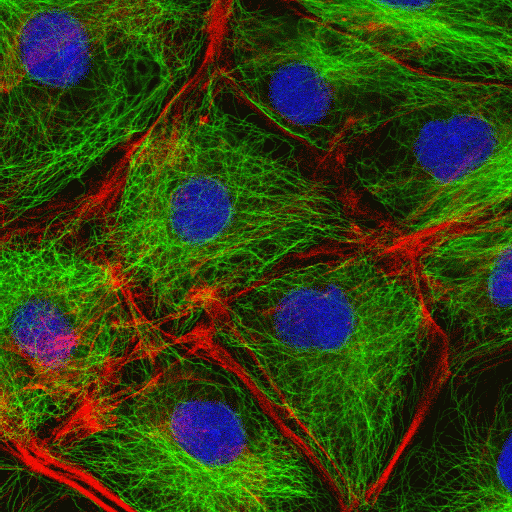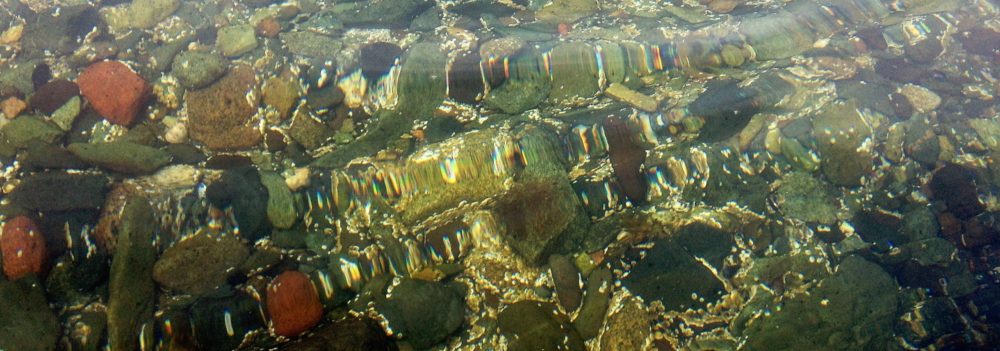
It was always thought that massage worked its miracles through increasing the circulation. The logic was that the cells would have more oxygen and nutrients and would be able to dispel wastes and carbon dioxide. In a better environment the cells could perform better at maintaining themselves and their matrix. It sounds good but it’s mostly wrong. Massage only increases circulation for a few hours at best. So why do we see increased rates of healing for days after a single massage? It all comes down to the cytoskeleton, the header image in this essay.
The cytoskeleton is an organelle of protein filaments and tubes which give the cell its structural integrity and serves as an intracellular transport network. In this gorgeous three minute short on the inner life of a cell, the cytoskeleton is seen as a grid like structure where filaments and tubules can be made or destroyed at will by enzymes. Make sure your sound is on.
It also shows organelles moving along the cytoskeleton. Among these are mitochondria slinking off to the right a little like an inch worm. Dynamin molecules are also seen pulling a vesical behind them much as a tug would tow a barge. At the end of the short, the white blood cell reorients its cytoskeleton so that it can squeeze through the seams in the capillary wall to enter the body spaces (presumably to fight an infection.) The grid like pattern of the cytoskeleton is what we find in healthy cells. This makes for a very efficient transport network so the cell can move its resources and energy production organelles to where it needs it the most to do its job. This is a cell with maximum productivity and minimum energy cost. However, not all cells are like this. Cells in distress and cells at injury sites are often found with a chaotic cytoskeleton that looks more like a Jackson Pollock.

Just try getting any work done in there! A cell like this will have a hard time moving its organelles and materials around internally to do its job. Basically it will require more energy to do less. Since the cells regenerate themselves and their surrounding tissues this is bad news for healing. This is why a diabetic patient might get decubitus ulcers. Your skin is constantly breaking down but if the rate or regeneration matches the rate of degeneration the outer cells fall off and are replaced by inner cells with no appreciable change in appearance or integrity. But if the rate of degeneration exceeds the rate of regeneration eventually the patient gets a hole in their body. By applying gentle friction around the margins of such a lesion the skin grows faster and closes the wound. How?
The cells do not just sit in the matrix of the tissues. The fibers of the matrix link across the cell membrane to the filaments of the cytoskeleton. When you tug on any tissue of the body, the movement goes all the way down to the cellular level. Before and after micrographs of cells that have had friction applied to them show that the cells somehow use the energy of the massage to reorient their cytoskeleton into a more efficient grid-like pattern. With a more efficient infrastructure the cell can now do more with less for days to come, increasing the regenerative abilities of the body to the point where it can catch up to and overtake the degeneration until the wound is healed. The heavier strokes of a massage alter the client’s cells by the billions. The body is already self-repairing. Massage simply increases the regenerative abilities of the body from the cellular level up. Healthier cells do more for you, no matter what stage your own health is in.
For those of you who want to read more on the cellular effects of massage you can read some extremely thorough research papers on the topic here and here.
As the tissue matrix tugs on the cytoskeleton, so the cytoskeleton tugs on the structures within the nucleus, including the chromosomes. It is possible that massage alters genetic expression itself, but at this time I have not found anything in the literature. If anyone has, please let me know.

brilliant